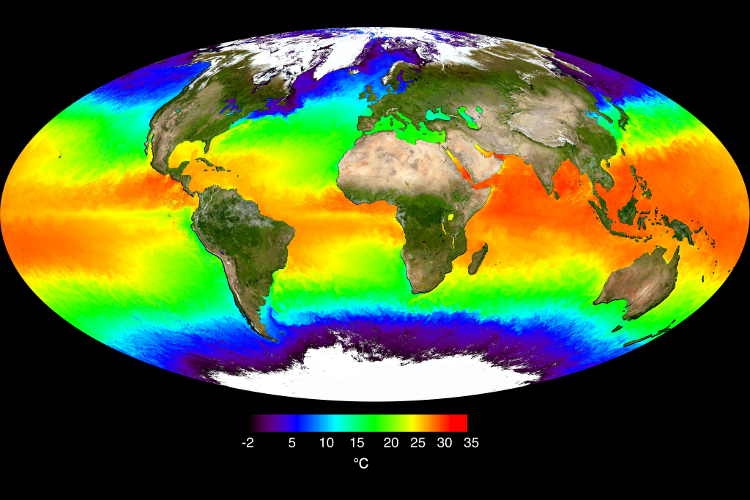Article originally published via MCJ Collective Climate Voices
Everyone following the climate crisis knows that we have a massive two-part challenge: reduce carbon emissions to zero, and remove excess carbon that has already been dumped into the atmosphere. If that weren’t hard enough, we must do it quickly, safely, cheaply, and at a massive scale.
When looking for recent examples of creating a huge impact fast, many people think about the explosive growth of the tech industry, so our instinct might be to use high tech approaches to address climate change. But what if I told you that a leading potential solution is an ancient, well-understood, and natural mechanism that has regulated the Earth’s thermostat for all of history?
The ocean is a critically important climate moderating force on our planet. Think about the atmosphere and the ocean as “mirrors” of each other. As we increase the concentration of CO2 in the atmosphere, some dissolves into the ocean. As a result, the ocean absorbs about 30% of our annual carbon emissions. As the largest carbon sink in the world, it holds some 50 times the amount of dissolved carbon as does the atmosphere. If we were to use ocean chemistry to meet the current IPCC goal of removing 10 gigatons of carbon dioxide from the atmosphere per year by 2050, we would increase ocean carbon by less than 1%.
The ocean-mineral carbon cycle is often called “Earth’s Thermostat” since it takes more carbon out of the air when the Earth is too hot, and less when it’s too cold. In this cycle, CO2 dissolves into rain, making it very slightly acidic. As it falls onto rocks around the world, which are frequently alkaline, it “weathers” off their top layer. This consumes the CO2 and forms dissolved bicarbonate which is balanced by metal ions from the rock, mostly calcium, magnesium or sodium — just like baking soda. A good portion of this mineral bicarbonate flows through rivers and streams and ends up in the ocean. This carbon then remains dissolved in seawater for centuries.
In the final part of the cycle, after 100,000 years, the bicarbonate splits into two pieces. One is a carbonate solid which sinks to the bottom of the ocean. The second piece is a CO2 molecule which, as a gas, floats to the surface and escapes back to the atmosphere to begin the cycle again.
Clearly, the ocean is a moderating partner in our fight against climate change.
The oceans, though, have already taken a huge blow from climate change. When too much CO2 dissolves into seawater, it forms a dangerous amount of acid and impedes shell formation in lobsters, mollusks, and corals. We are on a path where acidity will be above the livable range that marine organisms have adapted to over millions of years.
In the past 150 years, the oceans’ average acidity has increased dramatically, and conditions are especially stressful for coral reefs, whose area coverage has declined by 50% since 1950; we are now on a path to losing 99% of our coral coverage. This would mean the end of one of the most productive ecosystems on Earth by the end of the century, endangering the lives of more than 500 million people worldwide who rely on coral ecosystems for their livelihoods.

At the same time, alkalinity has been reduced by 30% — we need to get it back up to the right level. The Earth’s natural mechanism for adding alkalinity, described above, counteracts excess atmospheric CO2 and excess ocean acidity. The oceans will solve climate change without us having to do a thing!
Unfortunately, this will happen over hundreds of thousands of years. We just don’t have that kind of time.
Fortunately, we have the ingenuity to speed things up. Ocean alkalinity enhancement (OAE) can turn down Earth’s Thermostat through a process that simply generates and disperses alkalinity into the ocean. So far this has shown to be beneficial to corals and we expect it will be helpful to any sea animal that makes a shell. The process replicates the natural mineral-ocean cycle by increasing the amount of mineral bicarbonate we have in the ocean. Don’t worry, the ocean has lots of space for this — a relatively minor amount of carbon in the ocean has a massive impact on carbon in the atmosphere.
With OAE, when we add mineral antacid (think Rolaids) into the ocean, it reacts with dissolved CO2. The antacid “neutralizes” the acidic CO2 and makes bicarbonate, just like the mineral weathering process does on land. As a result, the concentration of CO2 in the ocean is reduced and more CO2 comes in from the atmosphere to replace it. Think of it like a conveyor belt, shuttling CO2 from the air into bicarbonate permanently and safely storing it in the chemistry of the ocean for 100,000 years.
We started Planetary Technologies to bring OAE into the family of approaches successfully removing carbon from the atmosphere.
Our process is based on our co-founder Dr. Greg Rau’s pioneering research at Lawrence Livermore National Labs and the University of California, Santa Cruz. We’re now past the theoretical phase of Greg’s research and working hard to implement it safely, with strong, independent, 3rd party oversight.
The next step for OAE is to prove that the theory and successful lab experiments apply in the large-scale ocean as well. We’re working with leading university labs to study biological and chemical effects and monitor the effectiveness of our process.
There are hundreds of opportunities for additional work in this field — from basic research to applied engineering to social science — please contact us if you are interested in getting involved! We are excited to work with existing and new ocean-focused individuals and teams to pioneer and scale OAE. Together we can remove billions of tons of carbon from our atmosphere and help to keep atmospheric CO2 below dangerous levels.
The ocean, which covers more than 70% of the Earth’s surface, can be our partner in meeting our climate goals over the rest of this century and beyond.



